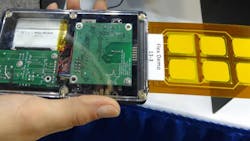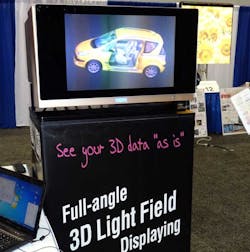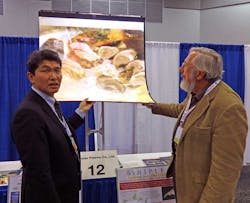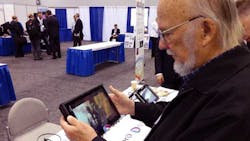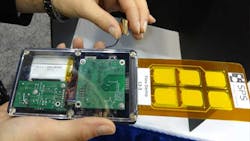SID 2013: Quantum Dots, Yes; Pico Projectors, Hardly Any
The exhibit floor at last week's Society for Information (SID) conference hd a few surprises and an interesting absence. My favorite section was the i-Zone, sponsored by E Ink, the source of the transflective, electronic paper technology behind the Kindle. i-Zone was the domain of not-quite-ready-for-prime-time technologies that otherwise would not have the financial resources to show off their chops at a major industry exhibition.
Among the large distributors, displays were bigger and brighter than ever, and, in some cases, bent in new ways. The most conspicuous exhibit, nearest the doors, was 3M's, which was focused on its quantum-dot film technology.
It's hard to get or give a clear explanation of quantum dots, which is why I'm expecting a contributed article from 3M. As nearly as I can make out, they're really small bits of semiconductor material that, when excited by a photon, re-emit a photon of a different wavelength that is related to the physical size of the quantum dot. The film is translucent, so it can be illuminated by a matrix of blue LEDs that is in-register with the red, green, and blue quantum dots in the film. The virtue of the quantum dots seems to be that in modulating the intensity of their output, it is possible to extend the possible color gamut beyond what can be achieved with the red, blue, and green LEDs's we are all familiar with.
The most interesting thing about this is that whenever I saw any exhibitor's illustration of the color gamut made possible by quantum dots, the gold standard for gamuts was the old NTSC gamut developed for color TVs in the 1950s. And guess, what, no semiconductor display technology today matches the entire NTSC gamut of old; they're competing with each other, but they can't quite hack a Sony Trinitron.
LG was another interesting exhibitor of large displays. The unusual thing at their exhibit was that the displays were curved, bent around a vertical or horizontal axis.
The point of the wrap-around feature was to provide peripheral-vision input in gamins situations. One exhibit, that wrapped around like an old Cinerama movie screen was running a simulation of a road-race game, and for me, the immersion effect made a significant difference in the way the game might be played. The screen next to it was bent around a a horizontal axis and was running a simulation of a combat helicopter mission, capturing something of the pilot's eye view as the craft skittered through the hostile air.
Maybe next year, there'll be an upside-down three-dimensional bucket display you can put your head into.
Still No Holotank, but Getting Closer – In the i-Zone
Moving on to the i-Zone. The Hungarian company Holografika’s 30-inch HoloVizo 80 WLT (Fig 1), was an eyecatcher. They call it a “no-glasses, full-angle, visualization system,” so it’s like looking into a holotank through a side window, in that you can see “behind” objects, as long as you can move far enough to the side. Still, this is the first time in my 3D display experience that objects can occlude other objects. Holografika’s literature says “there are no ‘sweet spots,’ no invalid zones or repeated views, and no “’ideal viewing distances.’”
The Holografika Web Site offers a terse explanation of the technology (which I have lightly edited): “The pixels, or rather voxels of the holographic screen emit light beams of different intensity and color in various directions. A light-emitting surface composed of these voxels acts as a digital window or hologram to show 3D scenes. The voxels of the holographic screen emit light beams of different intensity and color in the various directions. A light-emitting surface composed of these voxels will act as a digital window or hologram and show 3D scenes.”
Shinoda Plasma demonstrated a prototype of a flexible, large-area film display based on its luminous array film (LAFi) technology. (Fig 2) The demo module consists of a 1 x 1-meter display film, plus a drive circuit. The film is assembled from a 1000-unit array of 1-mm-long emissive glass tubes, sandwiched between electrode films. As the figure illustrates, the technology is light and bendable and the drive electronics can be separated for transportation, making it possible to roll up the display and transport it in a cardboard tube.
Without giving away much information about its technology, SuperD showed off its glasses-free 3D/2D capabilities. (Fig 3) All I could learn was that eye-tracking is involved, and that it is possible to mix multiple video sources so that part of the screen can show one 3D motion image; another part can show 3d from an entirely different source, and yet another part of the screen can show a 2D panel, possibly for editing. With good ergonomics, this would not be a terrible arrangement for on-the-fly video editing.
On the input side of the display equation, Strategic Polymers, demonstrated its very thin electro-mechanical (EMP) actuator technology for haptic feedback, embodied in the “Awake” keyboard (Fig 4) and the haptic-enabled “Backtouch” smartphone, in which keys that provide touch feedback are mounted on the opposite side of the phone from the display.
Other potentially neat stuff in the i-Zone included
· a reflective Fresnel lens-based floating 3-D display system with a 360° omni-directional viewing-zone that is evolving from work being done at the HoloDigilog Human Media Research Center at Kwangwoon University in Korea. The way it works is thatvideo images displayed on an LCD panel at the top side of system, are reflected back at the bottom side of the Fresnel lens. The reflected images are supposed to float in free space inside the display system. Unfortunately, it didn’t’ work for me.
· A sunlight-readable full color TFT LCD device from MacroDisplay that employed a Directional Light Guiding Film (DLGF) and a transparent window structure.
· What is said to be the world’s highest-resolution commercially-available stereo head mounted display (HMD), the SA-30, from SA Photonics. It provides a 30°horizontal field of view with better than 20/20 Snellen resolution. High-Res comes from WUXGA (1920 x 1200) OLED microdisplays.
· One exhibit I had a hard time understanding was Sun Innovations’ [].emissive projection display (EPD) technology. It works by projecting a high-energy non-visible optical image onto an optically-clear fluorescent screen. The idea is that, by selectively exciting RGB emissions from this multilayer transparent screen a full-color image can be generated. One application would be front-projection head-up displays for drivers or pilots, but I could never figure out the possibilities of rear-projection through the transparent glass.
· Several years ago, pico projectors were a big deal at SID but this year, the only one I stumbled across was in the i-Zone, where the Development Division of Citizen Holdings Co., Ltd. demonstrated a scanning MEMS pico-projection system based an RGB laser light source and a fiber-bundle RGB combiner. Unlike all other pico projector ideas I’ve seen, which make it possible to show your PowerPoint foils on the ceiling, this application can be used for head-up displays and, with appropriate sensors, ways of interacting with disabled citizens.
· Escaping from the limits of flat touch sensors, Canatu demonstrated a 3D shaped capacitive touch sensor. The demo has a 3D shaped surface and it is connected to a laptop to monitor the touch functionality over the 3D surface.
· And finally, there was INSiAVA’s all-CMOS microdisplay demonstrators with color, stereo and 3D capability are the first built on pure bulk silicon technology. They showed two head-wearable devices: a 3D, color head-wearable,128×96 pixel unit and an alphanumeric 64-ny-8 dot-matrix display.
About the Author
Don Tuite Blog
Don Tuite covers Analog and Power issues for Electronic Design’s magazine and website. He has a BSEE and an M.S in Technical Communication, and has worked for companies in aerospace, broadcasting, test equipment, semiconductors, publishing, and media relations, focusing on developing insights that link technology, business, and communications. Don is also a ham radio operator (NR7X), private pilot, and motorcycle rider, and he’s not half bad on the 5-string banjo.
